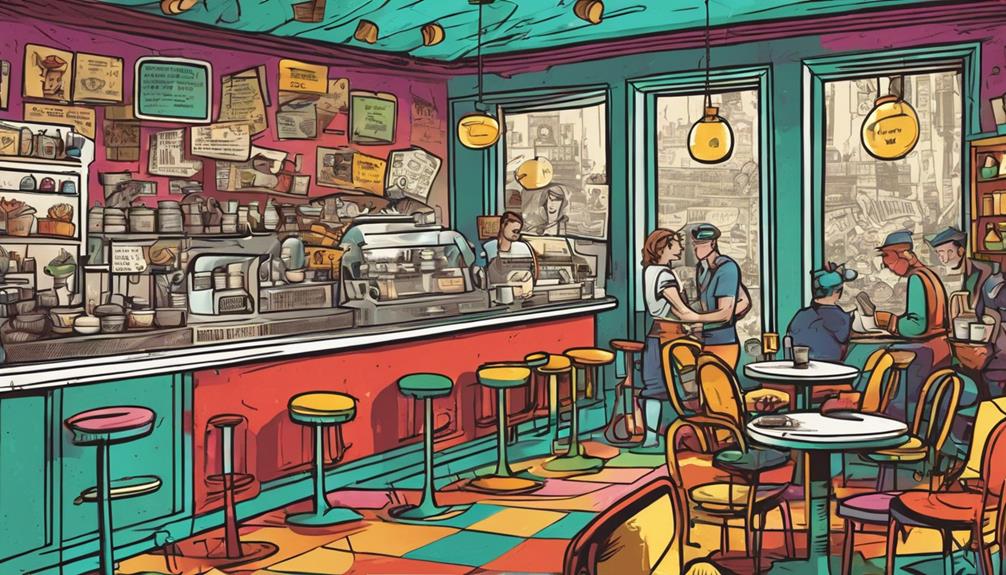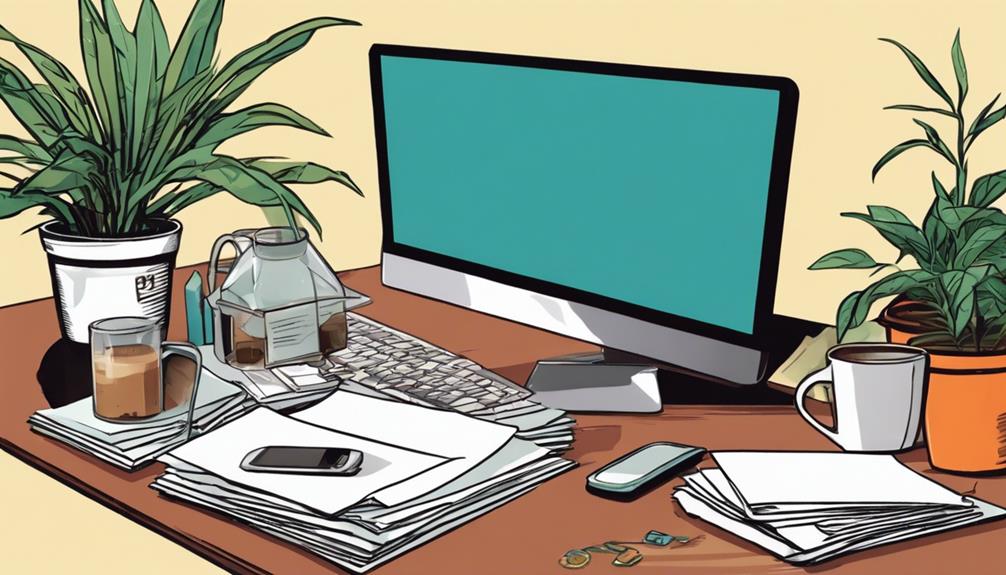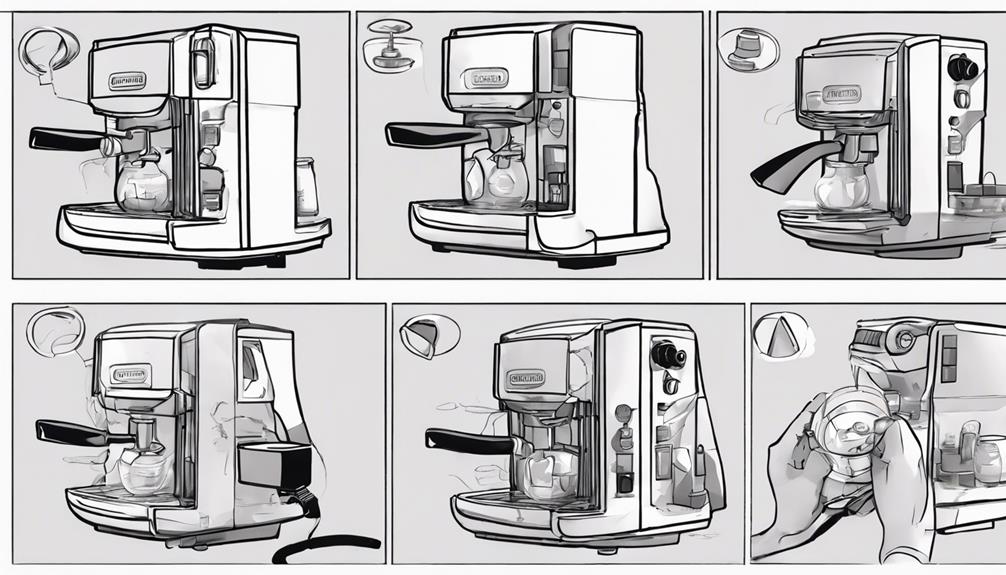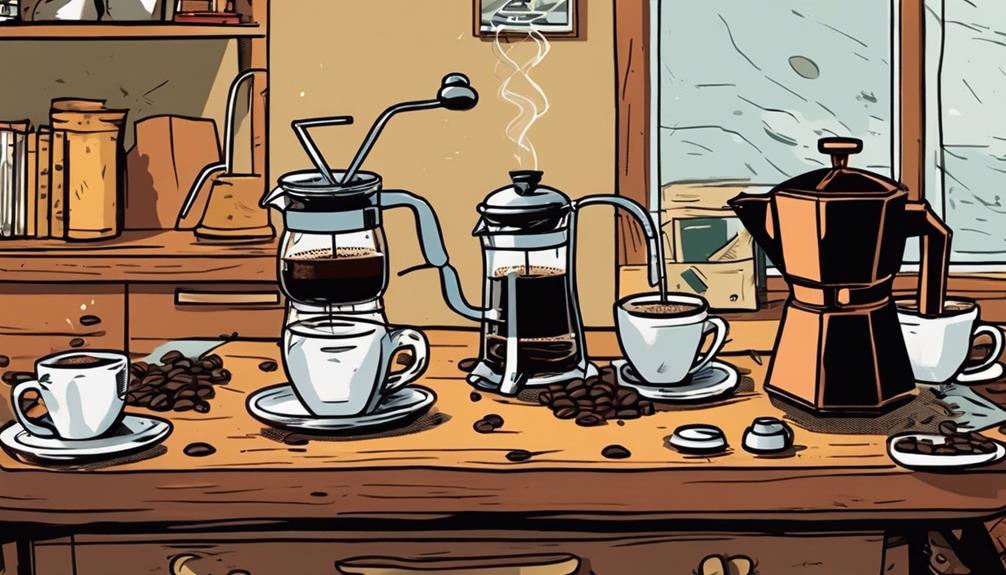To achieve the optimal flavor in your coffee, make sure to adjust the grind size according to your preferred brewing method. You can try using fine grinds for a faster extraction process or coarse grinds for a slower one. Burr grinders are recommended for their precise control over grind sizes, ensuring consistency. For example, a French press requires a coarse grind, while espresso calls for a very fine one. Keep in mind that the grind size can help balance acidity and bitterness, ultimately enhancing your coffee experience. Each brewing method has its own ideal grind size, which can significantly impact the taste of your brew. By mastering this skill, you can elevate your coffee game to a whole new level.
Key Takeaways
- Grind finer for shorter brew times, coarser for longer extraction.
- Use a burr grinder for consistent grind sizes.
- Adjust grind size based on taste preferences.
- Experiment to balance acidity and bitterness with grind size.
- Match grind size to brewing method for optimal flavor extraction.
Grind Size Basics and Impact
Understanding the basics of grind size is fundamental for mastering the art of brewing flavorful coffee. The grind size of your coffee beans directly impacts the extraction rate and ultimately the taste of your brew.
When the coffee grounds are finer, they extract faster due to increased surface area exposure. On the other hand, coarser grounds extract slower, leading to a different flavor profile.
Different brewing methods, such as pour over and espresso, are particularly sensitive to grind size variations. For example, finer grinds in espresso can affect the flow rate and extraction efficiency, while coarser grinds in pour over can impact the overall flavor balance.
Consistency in grind size is essential for achieving balanced coffee flavors and best brewing results. Remember, the grind size determines how quickly water dissolves coffee particles, directly influencing the taste of your brewed coffee.
Coffee Grinding Methods and Consistency
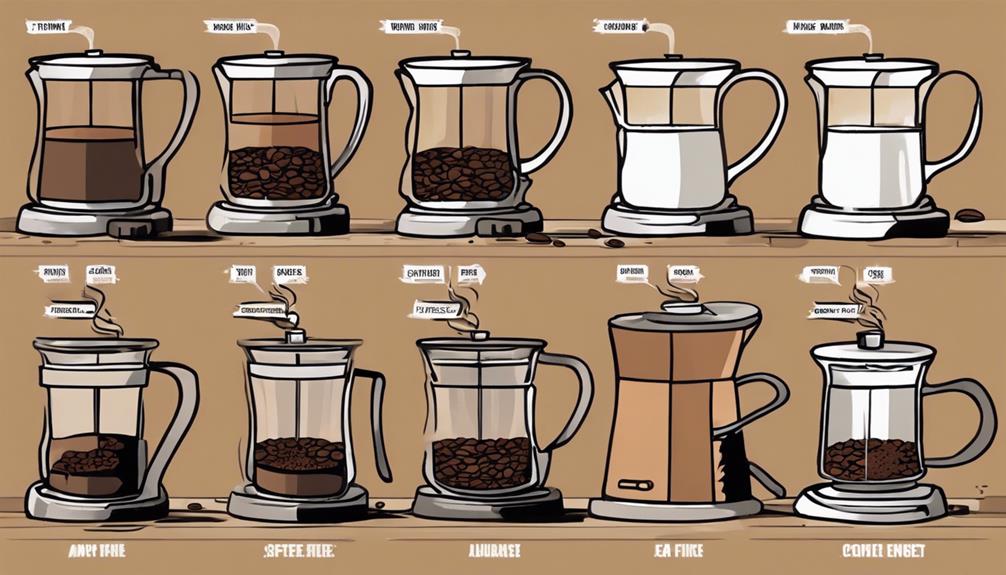
Consistently ground coffee is necessary for extracting balanced flavors, with burr grinders known for their ability to achieve uniform grind sizes. Burr grinders utilize sharp teeth to crush coffee beans uniformly, ensuring a consistent grind size that is essential for best coffee extraction. On the other hand, blade grinders chop beans with spinning blades, resulting in uneven grind sizes that can impact the overall flavor profile of your coffee.
Here's a comparison between Burr grinders and Blade grinders:
| Feature | Burr Grinder | Blade Grinder |
|---|---|---|
| Grind Consistency | Provides uniform grind sizes for balanced flavors | Tends to produce uneven grind sizes affecting extraction |
| Coffee Grounds | Crushes beans for consistent extraction | Chops beans leading to irregular grounds |
| Size | Offers control over grind size adjustments | Limited control over grind size |
For a more flavorful coffee experience, investing in a burr grinder can greatly enhance the consistency of your grind, ultimately improving the quality of your brew.
Grind Size for Different Brewing Methods
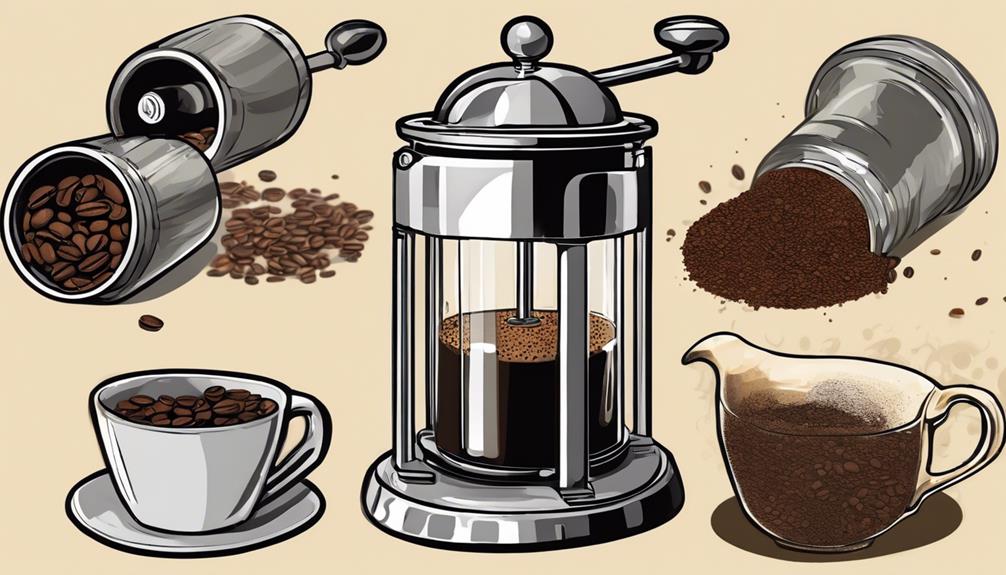
For ideal extraction and flavor, selecting the appropriate grind size tailored to your brewing method is essential. Grind size matters significantly when it comes to different brewing processes.
French press coffee benefits from a coarse grind to prevent seepage through the filter, resulting in a rich and full-bodied brew.
On the other hand, Espresso requires a very fine grind to resist high-pressure brewing and achieve proper extraction, delivering a concentrated and intense shot of coffee.
Pour-over and drip coffee methods work best with a medium grind size, allowing for a balanced extraction and a clean cup of coffee.
Cold brew, with its extended brewing time, calls for a coarse grind to extract flavors slowly without over-extraction.
Adjusting Grind Size for Taste and Techniques
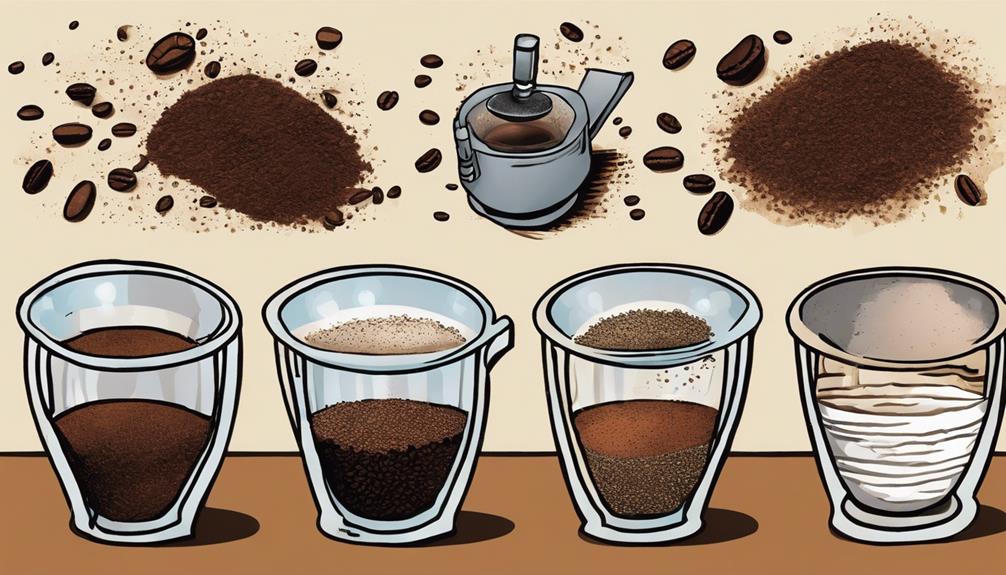
When adjusting grind size, you can directly impact the taste of your coffee, fine-tuning it to suit your preferences. If you prefer a stronger, bolder flavor, you can adjust the grind size to be finer, allowing for more extraction during the brewing process. On the other hand, if you enjoy a lighter, smoother taste, a coarser grind size may be more suitable. By adjusting manual coffee grinder, you can have complete control over the grind size, giving you the ability to tailor your coffee to your exact liking. This level of customization can greatly enhance your coffee drinking experience.
Experimenting with coarser or finer grinds can help you find the perfect balance between acidity and bitterness in your brew.
Tailoring grind size to different brewing techniques can elevate your coffee experience by enhancing flavors and extraction.
Taste Impact of Grind
Adjusting the grind size of your coffee beans directly impacts the taste of your brew. The grind size plays a pivotal role in determining the flavor profile of your coffee, influencing factors like acidity and bitterness. When you adjust the grind size, you can fine-tune the taste to suit your preferences. Finer grinds typically result in a more bitter taste, while coarser grinds tend to enhance the acidity of the brew. By making subtle changes in the grind size, you can experiment and tailor your coffee to achieve the perfect balance of flavors.
To help you understand how grind size affects taste, here's a table outlining the general impact on flavor based on grind size:
| Grind Size | Taste Impact |
|---|---|
| Finer | More Bitter |
| Coarser | More Acidic |
Technique-Specific Grind Adjustments
Fine-tuning your coffee grind size according to specific brewing techniques can greatly influence the flavor and overall quality of your brew.
When adjusting the grind size for different brewing methods at home, understanding the impact of coarser grinds for methods like French press, which can result in a fuller body and less bitterness, is crucial.
On the other hand, using finer grinds for espresso brewing can intensify the flavors and create a more robust taste profile.
By experimenting with grind sizes, you can adjust the extraction process and tailor your coffee to suit your preferences.
Understanding the recommended grind sizes for various brewing methods is vital for achieving the best extraction and flavor balance.
Whether you prefer a Chemex, AeroPress, or pour-over, adjusting the grind size can make a significant difference in your coffee's taste.
Grind Size Specifics for Brewing Methods
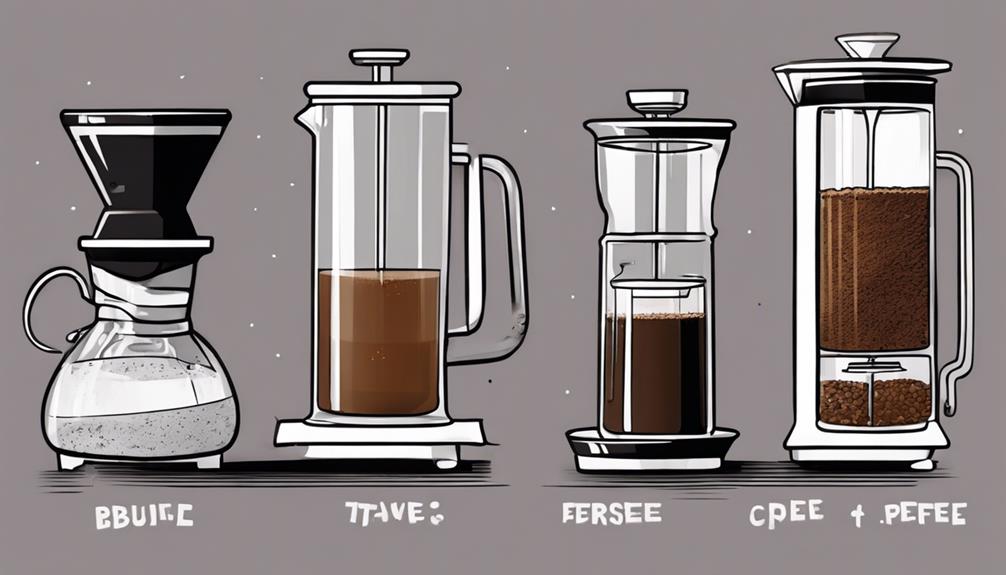
For specific brewing methods, consider the appropriate grind size to enhance the flavor extraction and brewing process. Different brewing methods require specific grind sizes to achieve the best results. Here is a breakdown of grind size specifics for common brewing methods:
| Brewing Method | Grind Size |
|---|---|
| French Press | Coarse |
| Drip Coffee Makers | Medium |
| Espresso | Fine |
| Pour-Over | Medium-Fine |
| Aeropress | Fine |
French Press coffee benefits from a coarse grind to prevent seepage through the filter and achieve a full-bodied brew. Drip coffee makers work best with a medium grind size to ensure the best extraction and a balanced flavor profile. Espresso brewing requires a fine grind size to resist high-pressure extraction, develop strong flavors, and create a creamy crema. Adjusting the grind size based on the brewing method can greatly enhance the taste and overall coffee experience.
Why Grind Size Matters
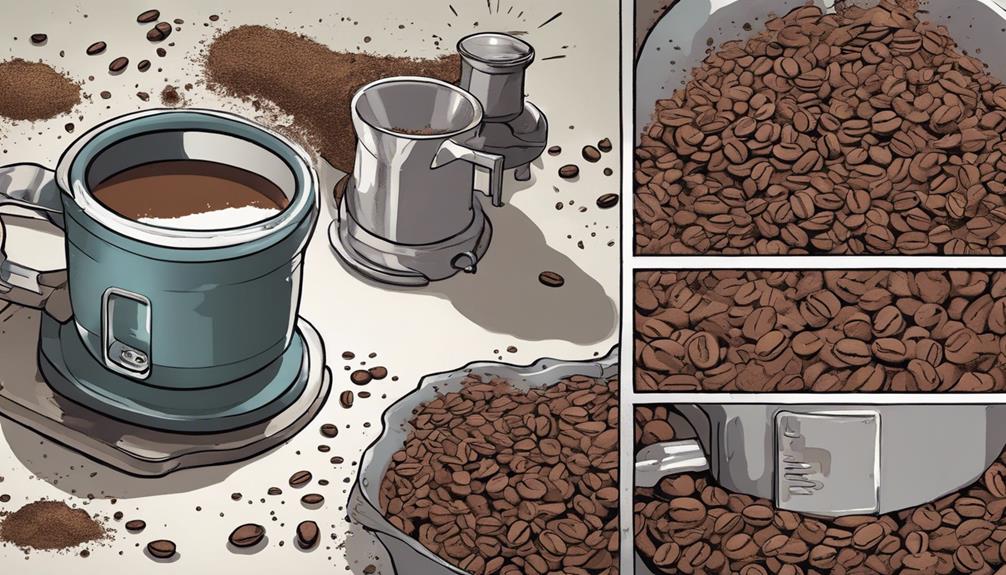
Understanding the importance of grind size is essential for mastering the art of coffee brewing. The grind size directly impacts the surface area of the coffee grounds, affecting how quickly water extracts flavor compounds during the brewing process.
Finer grinds have a larger surface area, extracting more quickly, leading to over-extraction if left in contact with water for too long. On the other hand, coarser grinds have a smaller surface area, resulting in slower extraction and potential under-extraction if not given enough time.
Adjusting grind size allows you to control the rate at which water extracts flavors from the coffee, influencing the overall taste of your brew. It's vital to find the right balance to avoid extracting too much, which can lead to bitterness, or extracting too little, resulting in a weak and underwhelming cup of coffee.
Which Grind Size Should You Use
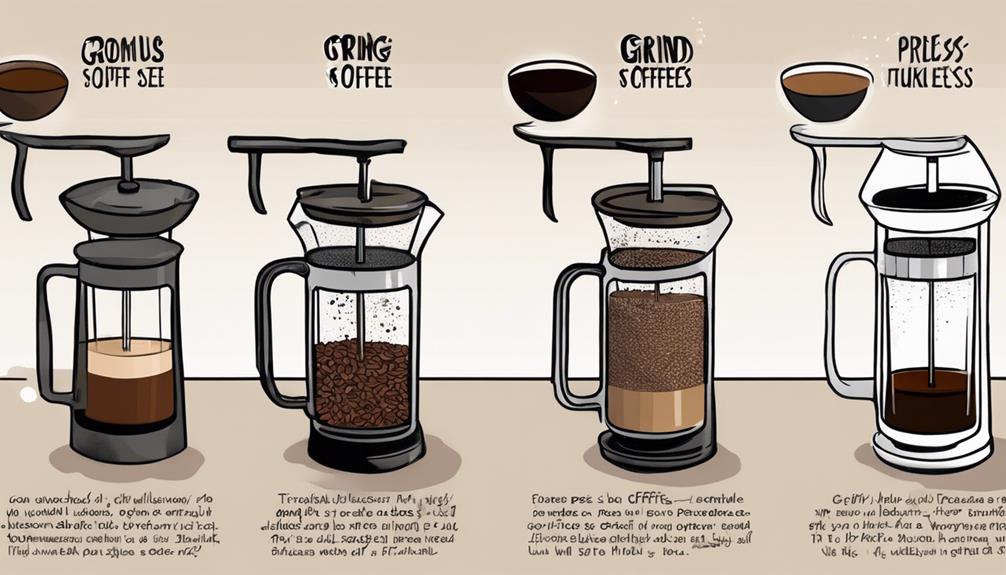
When deciding on the grind size for your coffee, it's important to take into account the brewing method you'll be using. Best grind sizes are customized to different brewing techniques to guarantee the finest flavor extraction possible.
Whether you're making Turkish coffee, espresso, AeroPress, siphon brews, or pour-overs, each method has a suggested grind size for excellent results.
Optimal Grind Sizes
To achieve the best flavor extraction and brewing results, selecting the appropriate grind size is necessary for each coffee brewing method. The grind size directly impacts the brew time and the flavors extracted from the coffee.
For example, a medium grind is suitable for drip coffee makers, while a finer grind is preferred for espresso due to its short contact time and high-pressure brewing process. Turkish coffee, known for its bold flavor, requires an extra fine grind size for quick extraction.
AeroPress suggests a medium to fine grind to achieve best extraction and taste balance. Siphon brewers find that a medium-fine grind helps balance the flavors extracted during the brewing process. Pour-over methods excel with medium to medium-fine grind sizes, resulting in a well-rounded cup of coffee.
Adjusting the grind size based on the specific brewing method is essential in enhancing the overall coffee experience.
Brewing Method Recommendations
For best flavor extraction and brewing results, selecting the appropriate grind size is essential for each specific coffee brewing method. When it comes to Turkish coffee, opt for an extra fine grind to facilitate quick extraction and intensify the flavor.
Espresso aficionados should stick to an extra fine grind to withstand high-pressure brewing and achieve a robust taste.
AeroPress users will find a medium to fine grind size ideal for balancing extraction and enhancing the flavor profile.
Siphon brewers can maximize extraction and enjoy complex flavors by using a medium-fine grind.
For pour-over methods, aim for a medium to medium-fine grind size to regulate the flow rate and extraction process effectively.
Brewing Methods and Grind Sizes
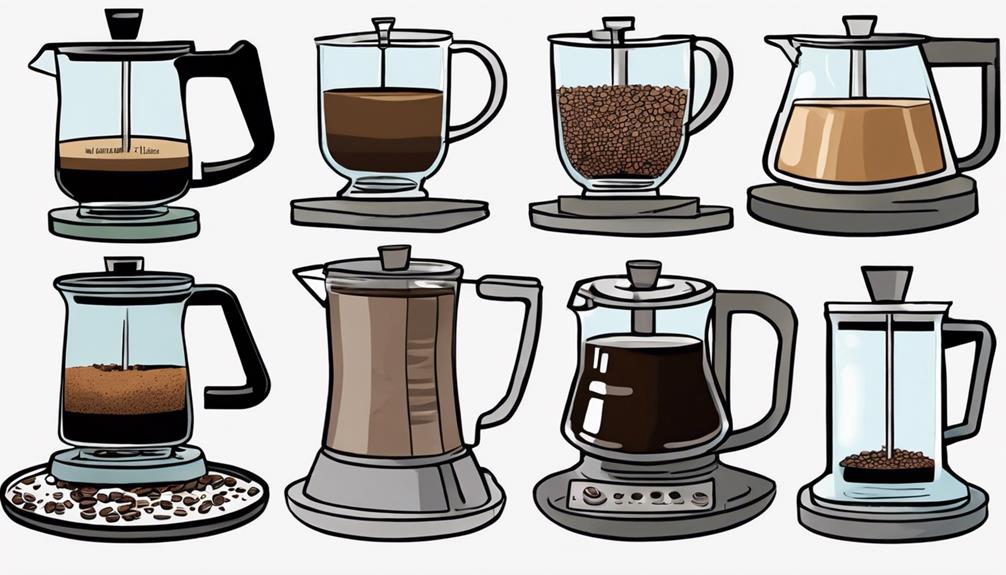
Adjusting the grind size based on the brewing method is crucial for achieving the desired flavor profile in your coffee.
For example, when grinding coffee for a French press, opt for a coarse grind to prevent seepage through the filter and extract a full-bodied brew.
Drip coffee makers, on the other hand, work best with a medium grind size to ensure optimal extraction and a balanced flavor profile.
If you're brewing espresso, a fine grind size is necessary for proper extraction, resulting in a strong flavor profile and a rich crema.
Different methods like pour-over and siphon brewing require specific grind sizes, ranging from medium to medium-fine, to achieve the best results.
Lastly, for cold brew coffee, a coarse or extra coarse grind size is ideal due to the extended brewing time, enhancing the final taste and texture.
Frequently Asked Questions
How Do I Change the Size of My Coffee Grinder?
To change the size of your coffee grinder, locate the dial or knob on your grinder. Turn it clockwise for a finer grind and counterclockwise for a coarser grind. Experiment with different settings to find your perfect cup!
How Do You Control Coffee Grind Size?
To control coffee grind size, adjust your grinder settings. Finer grounds for espresso, coarser for French press. Consistent size is key for flavor extraction. Customize to your taste. Experiment with grind size to find your perfect brew.
How to Choose Coffee Grind Size?
To choose coffee grind size, consider your brewing method – finer for espresso, coarser for French press. Experiment to find the sweet spot for balanced extraction and delicious flavor. Invest in a quality grinder for best results.
How Do I Adjust the Coarseness on My Coffee Grinder?
To adjust the coarseness on your coffee grinder, locate the dial or knob. Turn it clockwise for a finer grind or counterclockwise for a coarser one. Experiment with different sizes to find what suits your brew best.
Conclusion
So, remember, when it comes to coffee grind size, size really does matter!
Just like the saying goes, 'The proof is in the pudding.'
Experiment with different grind sizes to find the perfect balance for your desired taste and brewing method.
Your morning cup of coffee will thank you for it!

